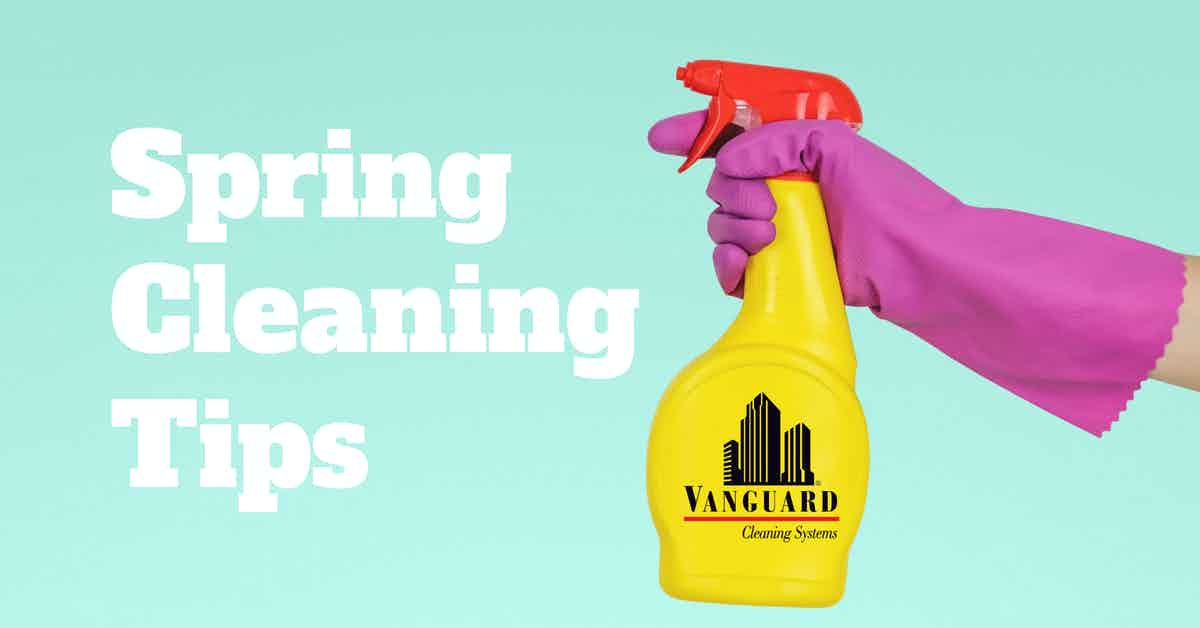Spring is an opportune time to address the facility damage caused by winter storms and prepare for autumn allergens.

Facility Spring Cleaning Tips
A well-laid spring cleaning agenda establishes the groundwork for a healthy and productive year.
Spring cleaning has several advantages, including:
- Improved facility appearance.
- Better indoor air quality.
- A reduction in the risk of infection, and;
- Increased occupant performance and job satisfaction.
The trick is often knowing where to start and what areas produce the highest return on investment while avoiding potential pitfalls.
Where to Start
Any cleaning plan should begin with a general inspection of the facility's interior, exterior, and critical systems.
Internally, look for:
- Stains, buildup, soil, or other damage to walls, ceilings, and floors.
- Signs of water damage from flooding or leaks in restrooms or overhead pipes.
- Loose flooring or stairway rails.
- Failing carbon monoxide and smoke detectors.
- Any sign of pest or rodent infestation.
- Clutter and debris in walkways or workspaces and;
- Any tripping hazards, including walkway and entry mats.
Additionally, inspect or test:
- Fire suppression systems, including extinguishers.
- Building alarms and;
- HVAC systems and filters.
Externally, inspect for:
- Broken or stained windows, damaged screens, and the presence of any pest infestations.
- Debris or pest infestation in downspouts and rain gutters.
- Trash and other debris in the parking lot, along walkways, in common areas, and garbage bin storage spaces.
- Any damage to landscaping, parking lots, and sidewalks, including large cracks and potholes.
- Damage to facility siding and paint, and;
- Loose railings or dry rot around decks and patios.
Essential Tips
Once your team has inspected the facility, they should have a good idea of what needs to be addressed, and can then determine what supplies are necessary to bring everything up to standard.
At that point, we recommend clearing out and organizing your cleaning closet.
- Identify hazardous disinfectant products or cleaning products that do not meet emerging sustainability requirements and replace them with Safer Choice or Eco Label products.
- Inspect, repair, or replace cleaning tools, including old mops, rags, and brooms, with microfiber alternatives.
- Ensure all safety data sheets are up to date, and;
- Take advantage of this opportunity to create or review cleaning checklists.
Once the cleaning closet is in order, it's time to start the actual cleaning process.
- Remove all clutter and garbage.
- Dust, starting high and working down to the floor.
- Deep clean all surfaces with a commercial-grade soap-based detergent applied with microfiber.
- Disinfect all surfaces, including desks and furniture, with an electrostatic disinfection sprayer.
- Deep clean restrooms and kitchens with a scrubber vacuum.
- Sweep and deep clean hard floors and walkways with a floor scrubber.
- Vaccum and service carpeting according to manufacturer recommendations.
- Service or swap out walkway and entry mats.
- Clean windows inside and out, and;
- Address all additional service items identified during the initial inspection.
Safety Precautions
When cleaning and disinfecting, it is possible to unintentionally expose yourself and others to harmful agents that can result in a lifetime of health issues, accidental poisoning, or fatalities.
To avoid potential hazards and workplace accidents, the U.S. Environmental Protection Agency (EPA) recommends the following actions:
- Minimize your chance of being exposed to contaminants - Follow product labels, and avoid cleaning around non-essential staff, particularly those with specific sensitivities or pre-existing medical conditions.
- Minimize the use of products or practices that may cause you or others in the area harm - Always use the least harmful product necessary to complete the task and never mix cleaning products or disinfectants, and;
- Increase ventilation before, during, and immediately after cleaning - Open windows and doors, increase mechanical ventilation and deploy portable fans to increase airflow and rapidly disperse airborne toxins.
References & Resources
- Facility Spring Cleaning: Where Should You Start?
- Five Essential Tips for Spring Cleaning Facilities
- How Facility Maintenance Helps With Cleaning Tasks
- Three Steps to Clean Your Way to Healthier Indoor Air
Takeaway
Spring cleaning has a demonstrable impact on occupant health and mental wellbeing, with reported benefits that include:
- Increased focus.
- Improved mood.
- Stress reduction, and;
- Improvements to physical health.
If this is your team's first time:
- Start small.
- Involve as many team members as possible, and;
- Look for engaging ways to make the process enjoyable for all participants.
Additionally:
- Always follow all safety precautions.
- Adhere to product manufacturer recommendations, and;
- Hire professionals to do the heavy lifting.
Outsourcing is a proven method for onboarding skilled service providers equipped with the latest training, processes, and technologies for a fraction of the price of maintaining a comparable service in-house.
Contact us today and discover why Vanguard Cleaning Systems® is the Standard of Clean® for businesses throughout Northwest Arkansas, Missouri, and Oklahoma.
In Oklahoma, dial 918-960-4450
In Arkansas, dial 479-717-2410
In Missouri, dial 417-812-9777

